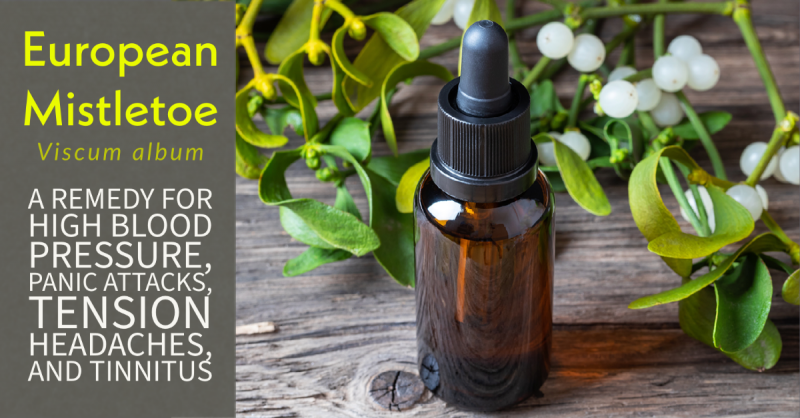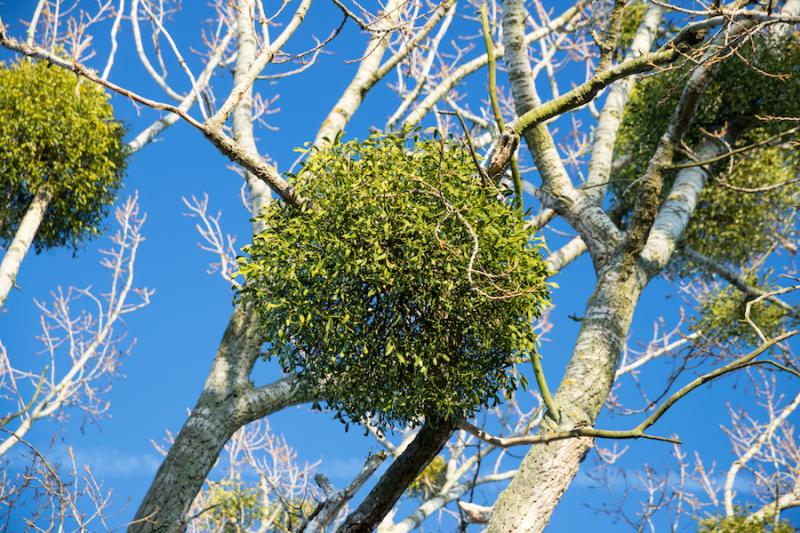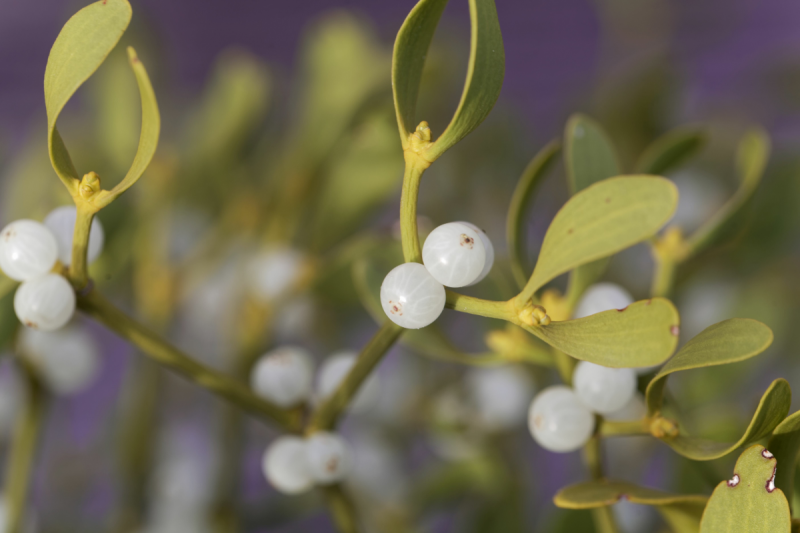
My first medicinal encounter with mistletoe was from the midwife who assisted in delivering my four children. She kept the remedy in her midwifery supplies to use as an agent to stimulate oxytocin, which causes uterine contractions. Although it can be used during labor to strengthen contractions, soften the cervix, and ease pain, I’ve never used it for that purpose.
In fact, for many years, I avoided using or even learning about mistletoe. I knew the berries are poisonous and that the leaves, despite being used in herbal medicine, are potentially toxic. I’ve since learned that my fears about using mistletoe were unwarranted. It’s a powerful remedy, but it’s simply not going to hurt anyone when used in normal doses.
However, caution is still required, many species, including the American varieties, are quite toxic. The species that is safe to use in normal doses is the European mistletoe, Viscum album, which is what we’ll be talking about in this article.
Powerful Nervine
The primary action of mistletoe is on the nervous system. Although I haven’t used it for nervous disorders, understanding its action on the nervous system is important. In The Earthwise Herbal, Matthew Wood quotes Richard Hool describing its properties.
As a nervine tonic I value mistletoe as superior to all other remedies I have come in contact with… When the decoction of mistletoe is given in from one or two teaspoonfuls to a wineglassful… every one, two, or three hours, particularly in fits, epilepsy, and St. Vitus’ dance, it will be found it soon soothes and quiets the irritability of the nervous system, at the same time giving tone and regularity of action, diminishing cerebral excitement, abating delirium, and controlling febrile excitement…”
Mistletoe, therefore, is a calming remedy, reducing irritability in the nervous system and quieting excess excitability. Its nervine action also affects the circulation, helping to calm the heart rate and lower blood pressure. That’s the purpose for which I’ve primarily used it.

Mistletoe, Blood Pressure and Asthma
My first real experience recommending mistletoe was with someone close to me. She had asthma, and regularly used inhalers. Like many asthmatics, she carried an emergency inhaler that delivered epinephrine to the bronchial passages to dilate them. We were making progress with her asthma, when she developed hyperthyroid, which caused her blood pressure and heart rate to climb to dangerous levels.
I started using bugleweed and lemon balm to calm the thyroid, and the addition of motherwort slowed the rapid heart rate, but the blood pressure was still high. She saw a doctor who prescribed a beta-blocker for her. She specifically asked about contraindications with her inhaler, and he assured her it was no problem. When she looked up information about the drug he prescribed she was very upset because there were warnings that it could interfere with her asthma.
Beta-blockers affect adrenergic receptors in the circulatory system. These are the receptor sites for epinephrine and the warnings for the prescribed drug said it could aggravate asthma.
So, she let me try to help her with lowering her blood pressure. After some consideration (and muscle testing) I settled on mistletoe with a small amount of lobelia. Lobelia also attaches to adrenergic receptors, which lower blood pressure, but also dilate the bronchi. Since she also had a very excitable nervous system, mistletoe also seemed appropriate. It worked to bring her blood pressure back to a more normal range.
Mistletoe and Circulation
 Ever since that time I’ve used mistletoe as one of my go-to remedies for serious blood pressure problems. I don’t use it with everyone, just stubborn cases involving people who seem nervous and high-strung. For best effect, I usually combine it with other remedies. A typical formula would be something like this: 4 parts linden, 2 parts mistletoe, 1 part lobelia.
Ever since that time I’ve used mistletoe as one of my go-to remedies for serious blood pressure problems. I don’t use it with everyone, just stubborn cases involving people who seem nervous and high-strung. For best effect, I usually combine it with other remedies. A typical formula would be something like this: 4 parts linden, 2 parts mistletoe, 1 part lobelia.
Linden is a very gentle remedy that works gradually over a period of time, also helping calm the nerves and lower blood pressure. I use it so the dose of mistletoe is kept lower avoiding anybody ingesting too much. If there is kidney involvement (as there often is in high blood pressure), I also add one part goldenrod, which I find helpful for many cases of high blood pressure, too. This is important because mistletoe shouldn’t be used with hypertension where there is water retention.
Besides high blood pressure, mistletoe can also be helpful for rapid heartbeat (tachycardia) and irregular heart rate. I’d also consider trying it in drop doses for panic attacks, tension headaches, tinnitus, and even epilepsy (in emergency situations). Extracts of mistletoe are also used for cancer, but the herb itself isn’t going to be of much help.
There are a few cautions one should observe with mistletoe. Don’t use it with people who are on high blood pressure medications. While small doses help to lower blood pressure, high doses can increase it. Mistletoe also contains tyramine and can cause sudden drops in blood pressure if someone is also taking a monoamine oxidase inhibitor.
I think it’s important that we not lose the ability to use some of our stronger botanical medicines, like mistletoe, because people aren’t properly educated in how to use them. And, since my experience with the plant is someone limited, If you have any experiences with using mistletoe, I’d love to hear from you.
Downloads
Steven's Articles
-

-
The Sensible Use of Caffeinated Herbs
Kola nuts, guarana, and yerba mate and other herbs…
-

-
The Health Benefits and Problems with Coffee
This popular caffeinated beverage can be beneficial…
October
-

-
Understanding Caffeine & Cellular Adaptation
Preserving the power of caffeine's buzz and the…
September
-

-
Horseradish
A pungent spice for aiding protein metabolism…
-

-
Banaba or Crepe Myrtle
A beautiful tree from Southeast Asia whose leaves…
August
-

-
Monkeyflowers
Flower essences to help see ourselves more clearly…
-

-
Mariposa Lilies
Strengthening the bond between mother and child…
-

-
The Noble Bay Leaf
A common kitchen herb for aiding digestion and…
-

-
Epimedium: Horny Goat Weed
A circulatory stimulant and kidney yang tonic…
July
-

-
The Medicinal and Nutritional Benefits of Apricots
A nutritious fruit and valuable medicinal seed for coughs
-

-
Dogwoods
Asian dogwood is used to stop excessive discharge,…
June
-

-
Neem: The Village Pharmacy
A popular Ayurvedic remedy for dental and immune…
-

-
Spilanthes: The Toothache Plant
A traditional remedy for teeth and gums, as well…
-

-
Forsythia
An anti-inflammatory, fever-reducing, and infection fighting herb
May
-

-
Buckwheat (Kashi)
A delicious, high protein, gluten-free, gut-healthy food

